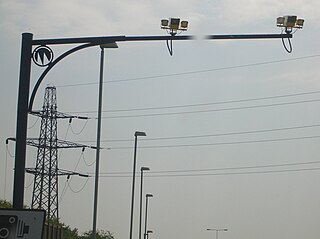
A home zone is a living street as implemented in the United Kingdom, which are designed primarily to meet the needs of pedestrians, cyclists, children and residents and where the speeds and dominance of cars is reduced. Quiet lanes are a similar concept in rural areas.

An L-plate is a square plate bearing a sans-serif letter L, for learner, which must be affixed to the front and/or back of a vehicle in many countries if its driver is a learner under instruction, or a motorcycle rider with provisional entitlement to ride restricted motorcycles.

Global Electric Motorcars (GEM) is an American manufacturer specializing in neighborhood electric vehicles (NEVs) since 1998 and low-speed vehicles (LSVs) since 2001. By October 2015 the company had sold over 50,000 GEM battery-electric vehicles worldwide. Originally owned by Chrysler, GEM was acquired by Polaris Inc. in 2011. In January 2022, it became a wholly-owned subsidiary of Waev.
The Locomotive Acts were a series of Acts of Parliament in the United Kingdom regulating the use of mechanically propelled vehicles on British public highways during the latter part of the 19th century.

The London to Brighton Veteran Car Run is the world's longest-running motoring event, held on a course between London and Brighton, England. To qualify, participating cars must have been built before 1905. It is also the world's largest gathering of veteran cars. The first edition, "The Emancipation Run" in 1896, celebrated the recently passed Locomotives on Highways Act 1896, which liberalised motor vehicle laws in the United Kingdom.

John Henry Knight, from Farnham, was a wealthy engineer, landowner and inventor. With the help of the engineer George Parfitt he built one of Britain's first petrol-powered motor vehicles, Frederick Bremer of Walthamstow having built the first in 1892. On 17 October 1895, with his assistant James Pullinger, they drove through Farnham, Surrey, whereupon he was prosecuted for using a locomotive with neither a licence nor a man walking in front with a red flag. This is sometimes misreported as the first person to be convicted of speeding in the UK, but that sobriquet subsequently fell to Walter Arnold of East Peckham, Kent, in January 1896.

Road speed limits in Ireland apply on all public roads in the state. These are signposted and legislated for in kilometres per hour. Speed limits are demarcated by regulatory road signs. These consist of white circular signs with a red outline. Speed limits are marked in black with "km/h" below the speed limit. Smaller "repeater" speed limit signs are used along stretches of road where there is no change in speed limit, in order to remind motorists currently on the road and to inform traffic merging from junctions that a certain speed limit applies.

The Road Traffic Act 1930 is an act of the Parliament of the United Kingdom introduced by the Minister of Transport Herbert Morrison.

A steam bus is a bus powered by a steam engine. Early steam-powered vehicles designed for carrying passengers were more usually known as steam carriages, although this term was sometimes used to describe other early experimental vehicles too.
The Road Fund was a British Government fund designated to pay for the building and maintenance of the United Kingdom road network. Its income came originally from Vehicle Excise Duty, until that ceased to be hypothecated for roads use in 1936, and then from government grants. It was created by the Roads Act 1920 and Finance Act 1920, and was wound up in the Miscellaneous Financial Provisions Act 1955.

The Locomotives on Highways Act 1896 removed the strict rules and UK speed limits that were included in the earlier Locomotive Acts which had greatly restricted the adoption of motorised vehicles in the United Kingdom. It came into operation on 14 November 1896.

The Road Traffic Act 1934 was an Act of the Parliament of the United Kingdom introduced by the Minister of Transport, Leslie Hore-Belisha. The Act was made in a year in which there had been a record numbers of road casualties.

The Roads Act 1920 was an Act of the Parliament of the United Kingdom which established the Road Fund, and introduced tax discs.

Speed limits are enforced on most public roadways by authorities, with the purpose to improve driver compliance with speed limits. Methods used include roadside speed traps set up and operated by the police and automated roadside 'speed camera' systems, which may incorporate the use of an automatic number plate recognition system. Traditionally, police officers used stopwatches to measure the time taken for a vehicle to cover a known distance. More recently, radar guns and automated in-vehicle systems have come into use.

Road speed limits in the United Kingdom are used to define the maximum legal speed for vehicles using public roads in the UK.

Road speed limit enforcement in the United Kingdom is the action taken by appropriately empowered authorities to attempt to persuade road vehicle users to comply with the speed limits in force on the UK's roads. Methods used include those for detection and prosecution of contraventions such as roadside fixed speed cameras, average speed cameras, and police-operated LIDAR speed guns or older radar speed guns. Vehicle activated signs and Community Speed Watch schemes are used to encourage compliance. Some classes of vehicles are fitted with speed limiters and intelligent speed adaptation is being trialled in some places on a voluntary basis.

Speed limits in the Philippines are specified in Republic Act No. 4136, or the Land Transportation and Traffic Code of the Philippines, which took effect on its approval on June 20, 1964. The act covers a number of areas other areas than speed limits, and was amended regarding some of those areas by Republic Act No. 10930, which was approved on August 2, 2017.

The Petroleum (Consolidation) Act 1928 is a UK Act of Parliament to consolidate the enactments relating to petroleum and petroleum-spirit. It specified and updated the conditions for the granting of licenses for keeping petroleum spirit; the labelling of containers for petroleum spirit; its transport; and regulations for certain uses.

The Motor Vehicles Act is an Act of the Parliament of India which regulates all aspects of road transport vehicles. The Act provides in detail the legislative provisions regarding licensing of drivers/conductors, registration of motor vehicles, control of motor vehicles through permits, special provisions relating to state transport undertakings, traffic regulation, insurance, liability, offences and penalties, etc. For exercising the legislative provisions of the Act, the Government of India made the Central Motor Vehicles Rules 1989.
Walter Charles Bersey was a British electrical engineer who developed electric-driven vehicles in the late 19th-century. He developed a new form of dry battery that enabled him to build, in 1888, an electric bus that he ran successfully for at least 3,000 miles (4,800 km). In March 1894 he built an electric parcel van that was used in central London and later developed electric private cars. Bersey also developed an electric cab design, 75 of which were built and used by the London Electrical Cab Company to run a service between 1897 and 1899. They were not financially successful owing to noise and vibration leading to excessive damage to tyres and batteries. In his later career Bersey developed designs for internal combustion engine cars and during the First World War served with the Royal Flying Corps and Royal Air Force.














